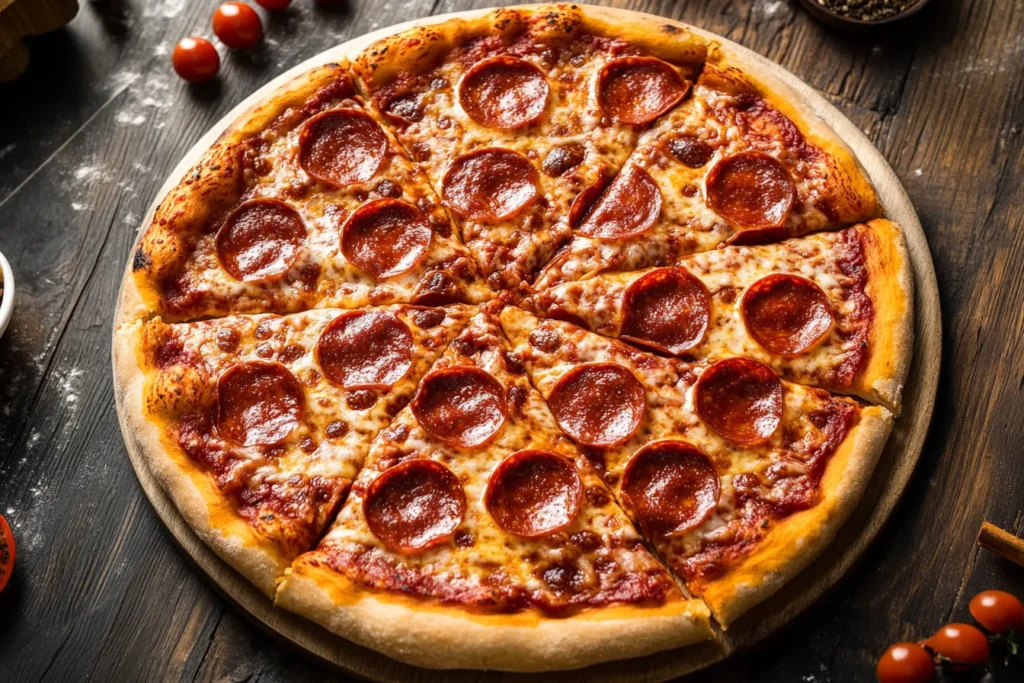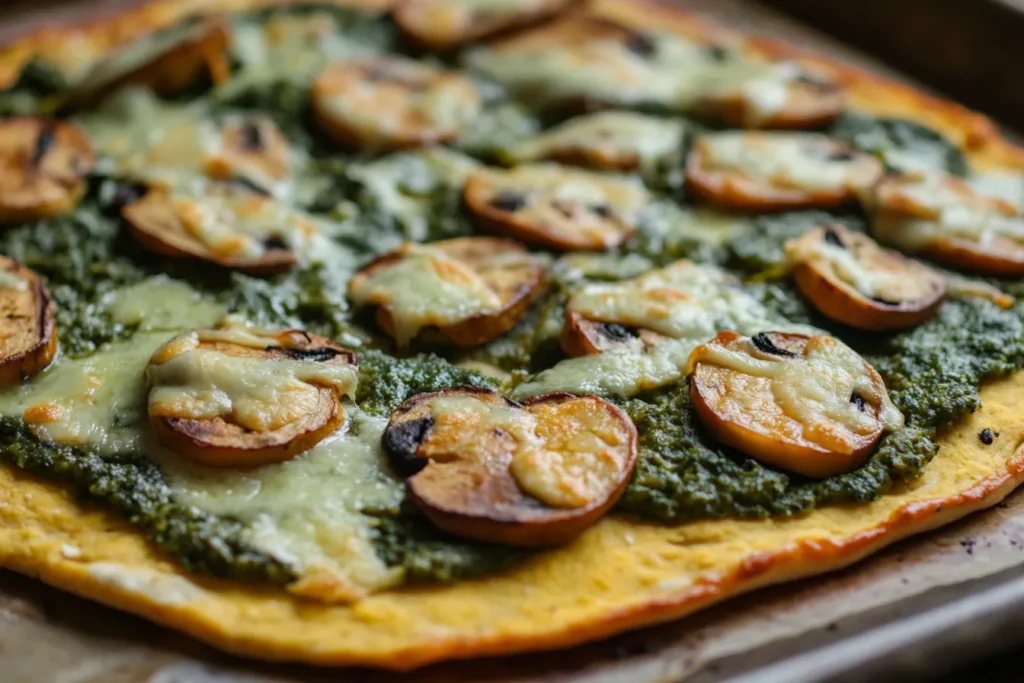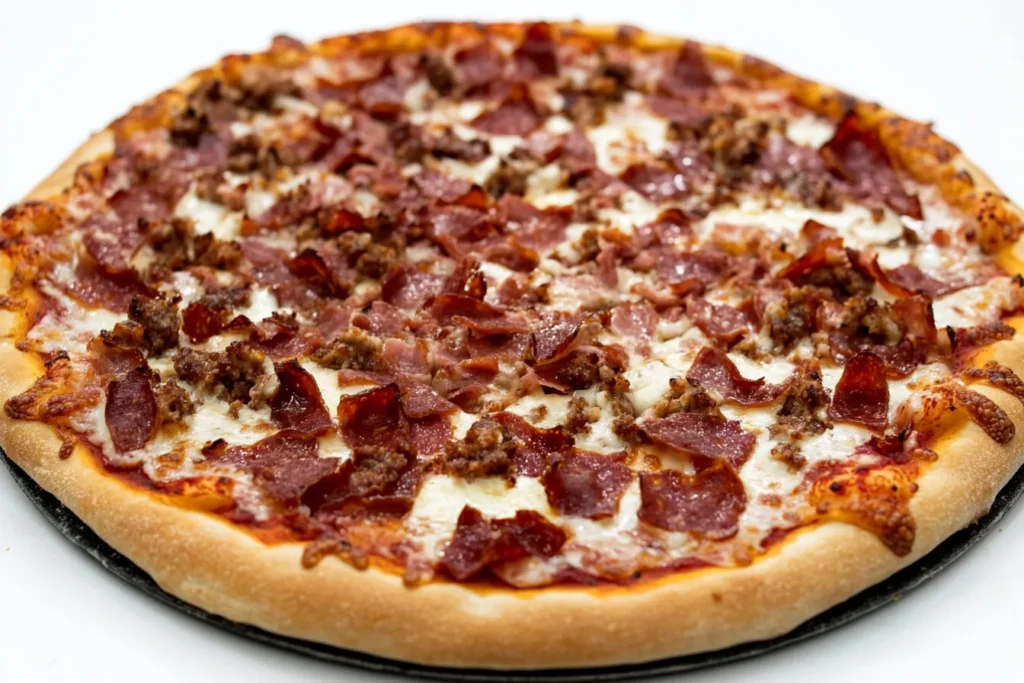Have you ever felt stuck trying to enjoy your favorite foods while juggling dietary restrictions or health concerns? If pizza night has become a challenge because of gluten, you’re in the right place. The good news? You don’t have to give up this beloved comfort food. Whether you’re managing celiac disease, gluten sensitivity, or simply exploring new food options, gluten-free pizza offers a delicious solution. With the right crust, toppings, and techniques, you can create a pizza that satisfies every craving—no compromise needed. Let’s dive into how you can bring the joy of pizza back to your table!
List Of Contents
Introduction to Gluten-Free Pizza
Gluten-free pizza has surged in popularity as more people embrace gluten-free diets for health, dietary, or medical reasons. Unlike traditional pizza, which relies on gluten-rich wheat flour, gluten-free pizza uses alternative flours and ingredients to replicate the doughy goodness that pizza lovers crave. But why opt for gluten-free?
- For some, it’s a medical necessity due to conditions like celiac disease or gluten sensitivity.
- For others, it’s a lifestyle choice tied to perceived health benefits or trends in clean eating.

While it provides a valuable alternative, gluten-free pizza often surprises new consumers with its unique taste and texture, sparking curiosity about what makes it so different. check out more recipes here.
What is Gluten?
Gluten is a type of protein present in wheat, barley, and rye. It plays a critical role in baking, particularly in traditional pizza making. Here’s why:
- Texture and Elasticity: Gluten creates a protein network that traps air bubbles, providing dough with its chewiness and flexibility.
- Flavor: In addition to its structural role, gluten adds delicate flavors that enhance the dough’s savory taste.
Without gluten, dough misses the signature stretch and softness of traditional pizza, prompting bakers to explore innovative alternatives. check out more recipes here.
Ingredients in Gluten-Free Pizza
Common options include:
- Rice Flour: A staple for its mild flavor and smooth texture.
- Almond Flour: Adds a nutty flavor and moist texture.
- Tapioca Starch: Contributes elasticity and chewiness.
- Coconut Flour: Known for its sweetness and density.
Each type of flour has unique characteristics that affect the taste and texture of the final product. For instance, almond flour may make the crust richer and slightly denser, while tapioca creates a more elastic dough. check out more recipes here.
The Science of Dough Formation
In traditional pizza, gluten forms a stretchy, cohesive structure that holds gases from yeast fermentation, creating a light and soft dough. Gluten-free dough, however, lacks this natural binder, leading to challenges in replication:
- Elasticity: Gluten-free dough tends to be more brittle and harder to shape.
- Binding Agents: Ingredients like xanthan gum or guar gum are often added to mimic gluten’s structure, helping to hold the dough together.
Types of Gluten-Free Flours
Every alternative flour offers distinct characteristics to enhance gluten-free pizza:
- Almond Flour: Offers a subtle nutty flavor and high moisture retention.
- Coconut Flour: Dense and absorbent, it requires more liquid in recipes.
- Rice Flour: Neutral in flavor but may result in a slightly grainy texture.
- Tapioca Starch: Adds a chewy consistency to mimic gluten’s elasticity.
These flours are often most effective when combined, as no single alternative can fully replicate wheat’s properties. check out more recipes here.
Nutritional Differences
Switching to gluten-free pizza introduces some nutritional shifts:
- Gluten-free options often use refined starches, increasing carbohydrate content while reducing fiber.
- Alternative flours, like almond or coconut, may boost protein and healthy fats.
- Some recipes compensate for texture with added sugars and oils, potentially increasing calorie counts.
While gluten-free pizza can fit many dietary preferences, it’s essential to balance taste with nutritional value. check out more recipes here.
The Role of Binders in Gluten-Free Pizza
Without gluten, achieving a cohesive dough relies on binders like:
- Xanthan Gum: A widely used stabilizer that enhances stretch and elasticity.
- Guar Gum: Improves dough texture and prevents crumbling.
These ingredients help replicate the chewy texture of traditional pizza, though they may slightly influence the flavor.
Moisture and Crumb Structure
One of the common complaints about gluten-free pizza is its density. Without gluten’s airy structure:
- The crumb tends to be tighter and less spongy.
- Retaining moisture is harder, often leading to dry or crumbly crusts.
Innovations in recipe development aim to tackle these issues by blending flours and improving hydration.
Cultural and Regional Variations
Globally, gluten-free pizza incorporates local flavors and preparation techniques:
- Italian Variants: Focus on traditional toppings with almond and rice flour crusts.
- American Versions: Heavier on starches like tapioca for a chewier base.
- Asian Adaptations: Use rice and sweet potato flours, resulting in unique textures.
These variations showcase how cultural preferences influence gluten-free pizza recipes.
Consumer Expectations
When it comes to gluten-free pizza, consumer preferences can vary widely. Some crave a close approximation to traditional pizza, while others embrace the distinct nutty and earthy flavors of alternative flours.Meeting these expectations presents an ongoing challenge for both manufacturers and chefs.
Why Gluten-Free Pizza Tastes Different

Texture Challenges
One of the most immediate differences between traditional and gluten-free pizza is the texture. Gluten is essential for creating the stretch and chewiness of traditional pizza dough. Its protein structure traps air bubbles, forming a light, airy crumb. Without gluten, dough faces significant challenges:
- Brittle Structure: Gluten-free doughs often lack elasticity, making them prone to cracking.
- Firm or Gritty Mouthfeel: Many gluten-free flours, like rice or corn, can result in a coarser texture.
- Denseness: Without gluten’s network, the dough tends to collapse or become overly dense.
This difference in texture can surprise first-time consumers, as the bite feels entirely distinct from the soft chewiness they might expect.
Flavor Profile Changes
Without wheat flour, the subtle nutty and toasty flavors characteristic of traditional pizza are lost. Gluten-free flours bring their own set of characteristics, which can significantly alter the taste:
- Earthy Notes: Almond and coconut flours add nutty, slightly sweet undertones.
- Neutral Profiles: Rice flour lacks flavor, which can lead to a blander crust unless enhanced with herbs or spices.
- Sweetness: Some gluten-free flours and binders contribute a mildly sweet flavor, especially tapioca starch.
These flavor differences might appeal to adventurous eaters but can feel jarring to those accustomed to classic pizza dough.
Baking Differences
The baking process for gluten-free pizza varies significantly due to the dough’s unique chemistry. Traditional pizza dough relies on gluten for oven spring—the rise that occurs during baking. Gluten-free doughs require different strategies:
- Lower Baking Temperatures: Prevents over-drying or hardening of the crust.
- Shorter Bake Times: Ensures the crust stays tender.
- Pre-Baking: Many recipes call for par-baking the crust to create a firm base before adding toppings.
These adjustments often result in a crust that is thinner, crispier, or more cracker-like.
Crust Thickness and Shape
Gluten-free pizza often comes with a thinner crust, and there are practical reasons for this:
- Structural Integrity: A thicker gluten-free crust is more prone to breaking apart.
- Moisture Distribution: Thin crusts bake more evenly, reducing the risk of undercooked or gummy dough.
While some people enjoy the crunch of a thin crust, it can feel more like a flatbread than the soft, pliable base of traditional pizza.
Aroma Variations
A pizza’s aroma is a vital part of the eating experience. The switch to alternative flours introduces new and distinct smells. For instance:
- Nutty Aromas: Almond flour imparts a warm, nutty fragrance during baking.
- Neutral Scents: Rice and tapioca flours produce less aroma, making the toppings more pronounced.
- Sweet Hints: Coconut flour can add a subtle sweetness that mingles with savory ingredients.
These differences can either enhance or detract from the overall sensory experience, depending on individual preferences.
Yeast Fermentation Impact
In traditional dough, yeast fermentation produces gases that gluten traps, creating the dough’s airy structure and contributing to its flavor. Gluten-free doughs struggle to replicate this:
- Limited Rise: The absence of gluten means fewer air pockets, resulting in a denser texture.
- Flavor Challenges: Yeast flavors are less pronounced, leading to a milder taste.
Some gluten-free recipes bypass yeast entirely, further reducing the flavor complexity.
Additives and Preservatives
To mimic gluten’s properties, gluten-free pizzas often rely on stabilizers and emulsifiers. These include:
- Xanthan Gum: Adds elasticity and prevents dough from crumbling.
- Guar Gum: Improves texture and cohesion.
- Potato Starch: Enhances chewiness.
While these additives improve structure, they can slightly alter the flavor and texture, sometimes creating an unfamiliar aftertaste.
Sweetness Variations
A common complaint about gluten-free pizza is its unexpected sweetness. This arises from:
- The use of naturally sweet flours like coconut or cassava.
- Added sugars to improve flavor and browning during baking.
While a touch of sweetness can balance savory toppings, it may stand out for those expecting a traditional, neutral crust.
Sauce and Topping Adjustments
To complement gluten-free bases, chefs often adapt sauces and toppings:
- Bolder Flavors: Strong cheeses, spicy meats, and tangy sauces mask the mild or earthy notes of alternative flours.
- Lighter Sauces: Prevent overwhelming thinner, more delicate crusts.
These adjustments aim to enhance the overall experience while compensating for the base’s differences.
Consumer Perception
Finally, consumer perception plays a major role in how gluten-free pizza is experienced. For those expecting a replica of traditional pizza, the differences in texture, flavor, and aroma may feel like a letdown. However:

- Open-minded eaters often appreciate the unique qualities of gluten-free pizza.
- Branding and presentation also influence expectations. A pizza marketed as artisanal or health-focused may be received more positively.
Innovations in Gluten-Free Pizza Making
The gluten-free pizza landscape has evolved significantly in recent years, with advances in techniques and ingredients aimed at mimicking the traditional pizza experience. Key innovations include:
- Modified Starch Blends: New starch combinations replicate gluten’s elasticity, improving dough stretchability.
- Fermented Alternative Flours: Fermentation enhances the flavor of rice and almond flours, mimicking the complexity of traditional yeast-risen dough.
- Specialized Enzymes: These enzymes enhance structure and texture in gluten-free baking.
Emerging technologies are bridging the gap, creating products that satisfy both gluten-free consumers and traditional pizza lovers.
Experimenting with Flavors
One way to improve gluten-free pizza is through thoughtful flavor pairings:
- Adding Herbs and Spices to Dough: Ingredients like rosemary, garlic powder, or paprika can mask the earthy notes of alternative flours.
- Bold Toppings: Spicy meats, tangy sauces, and umami-rich vegetables (e.g., mushrooms, olives) complement the distinct flavors of gluten-free crusts.
- Infused Oils: Brushing olive oil infused with garlic or chili on the crust before baking enhances aroma and taste.
Experimenting with these techniques can elevate gluten-free pizza beyond a mere alternative to wheat-based options.
Improving Texture
One of the most significant hurdles for gluten-free pizza is achieving a satisfying texture. New binders and techniques are helping to close the gap:
- Psyllium Husk: A plant-based fiber that improves dough elasticity and moisture retention.
- Chia or Flax Seeds: When hydrated, these seeds form a gel-like consistency that acts as a natural binder.
- Blended Flours: Combining almond flour, tapioca starch, and potato starch creates a balance of chewiness and crispiness.
These advances allow bakers to produce crusts that feel closer to traditional dough in the mouth.
Enhancing Moisture Retention
Dryness is a common complaint about gluten-free pizza, but it can be mitigated with these strategies:
- Hydrating Dough: Using more water in gluten-free recipes ensures the crust doesn’t dry out during baking.
- Fat Content: Adding olive oil or butter improves the dough’s ability to retain moisture.
- Covered Baking: Baking the pizza with a cover or foil for part of the cooking time helps trap steam.
These techniques not only improve moisture retention but also create a softer crumb structure.
Optimizing Baking Techniques
Getting the best results from gluten-free dough often comes down to baking techniques:
- Use of Pizza Stones or Steel: These tools provide even heat distribution, ensuring a crisp yet tender crust.
- Preheating the Oven: High initial heat helps set the crust quickly, preventing sogginess.
- Par-Baking: Baking the crust alone for a few minutes before adding toppings prevents a gummy center.
Attention to baking details ensures the final product is not only palatable but delightful.
DIY Gluten-Free Pizza Tips
Making gluten-free pizza at home can be a rewarding experience. Follow these tips for success:
- Choose High-Quality Flours: Opt for trusted brands or blends that combine multiple flours for a balanced texture.
- Experiment with Ratios: Blend almond and rice flours with tapioca starch for a more authentic crust.
- Add Binders Carefully: Start with small amounts of xanthan gum or psyllium husk, adjusting as needed.
- Use Parchment Paper: It prevents sticking and ensures easy transfer to and from the oven.
Homemade gluten-free pizzas allow for customization and better control over taste and texture.
Store-Bought vs. Homemade
The choice between store-bought and homemade gluten-free pizzas comes with trade-offs:
- Store-Bought: Convenient and consistent but often includes preservatives and artificial flavors.
- Homemade: Offers fresher taste and the ability to customize but requires more time and effort.
Understanding your priorities—whether convenience or quality—is key when deciding which option to pursue.
Balancing Nutritional Value
Gluten-free pizzas often compensate for missing gluten with added starches and sugars, but there are ways to boost their nutritional profile:
- Whole Grain Flours: Use flours like sorghum or teff for added fiber and nutrients.
- Seeds and Nuts: Incorporating sunflower seeds or walnuts into the dough boosts protein and healthy fats.
- Vegetable Purees: Adding sweet potato or pumpkin puree enhances flavor and moisture while increasing vitamins.
Balancing taste and health creates a more satisfying meal for gluten-free diners.
Popular Gluten-Free Pizza Brands
Several brands have gained popularity for their high-quality gluten-free offerings. Some notable examples include:
- Udi’s: Known for its crispy crusts and balanced flavor.
- Caulipower: A cauliflower-based crust that appeals to low-carb and gluten-free eaters.
- Amy’s Kitchen: Offers a range of organic and gluten-free pizzas with diverse topping options.
These brands continue to refine their recipes to cater to growing consumer demand.
Restaurant Innovations
Restaurants are increasingly embracing gluten-free options, with many going beyond basic offerings:
- Dedicated Gluten-Free Kitchens: Reducing cross-contamination for customers with celiac disease.
- Creative Toppings: Gourmet ingredients like truffle oil or burrata elevate gluten-free pizzas to new heights.
- Wood-Fired Ovens: These enhance flavor, creating a smoky, charred crust that offsets the limitations of gluten-free dough.
This adaptability reflects the growing importance of gluten-free diners in the culinary world.
The Future of Gluten-Free Pizza
As demand for gluten-free options continues to rise, the future looks promising:
- Lab-Grown Gluten Proteins: Scientists are working on replicating gluten proteins in the lab for use in gluten-free products.
- Enhanced Flour Blends: Improved formulations that closely mimic wheat flour.
- Sustainability: Alternative flours derived from sustainable sources like cassava or chickpeas are gaining traction.
These advancements aim to make gluten-free pizza indistinguishable from its traditional counterpart.
FAQs
- What is the main reason gluten-free pizza tastes different?
- The lack of gluten impacts both texture and flavor, requiring alternative flours and binders that contribute distinct characteristics.
- Can gluten-free pizza ever taste like regular pizza?
- While it’s difficult to replicate exactly, innovations in flour blends and baking techniques are closing the gap.
- Why is gluten-free pizza often more expensive?
- Alternative flours and specialized ingredients increase production costs.
- Is gluten-free pizza healthier?
- Not necessarily—it depends on the ingredients used. Some versions may have higher starch and sugar content.
- Why is gluten-free crust often thin?
- Thin crusts reduce the risk of cracking or breaking, common in gluten-free doughs.
- How do binders like xanthan gum affect taste?
- They primarily affect texture, but excessive use can sometimes add a slight aftertaste.
- What’s the best flour combination for gluten-free pizza?
- A mix of almond, tapioca, and rice flours often works well for balance.
- Why does store-bought gluten-free pizza taste so different?
- Preservatives and stabilizers used in pre-packaged products can alter flavor.
- How can I make gluten-free pizza less dry?
- Use more liquid in the dough and add ingredients like olive oil to retain moisture.
- Are there gluten-free vegan pizzas available?
- Yes, many brands and restaurants now offer gluten-free vegan options.
